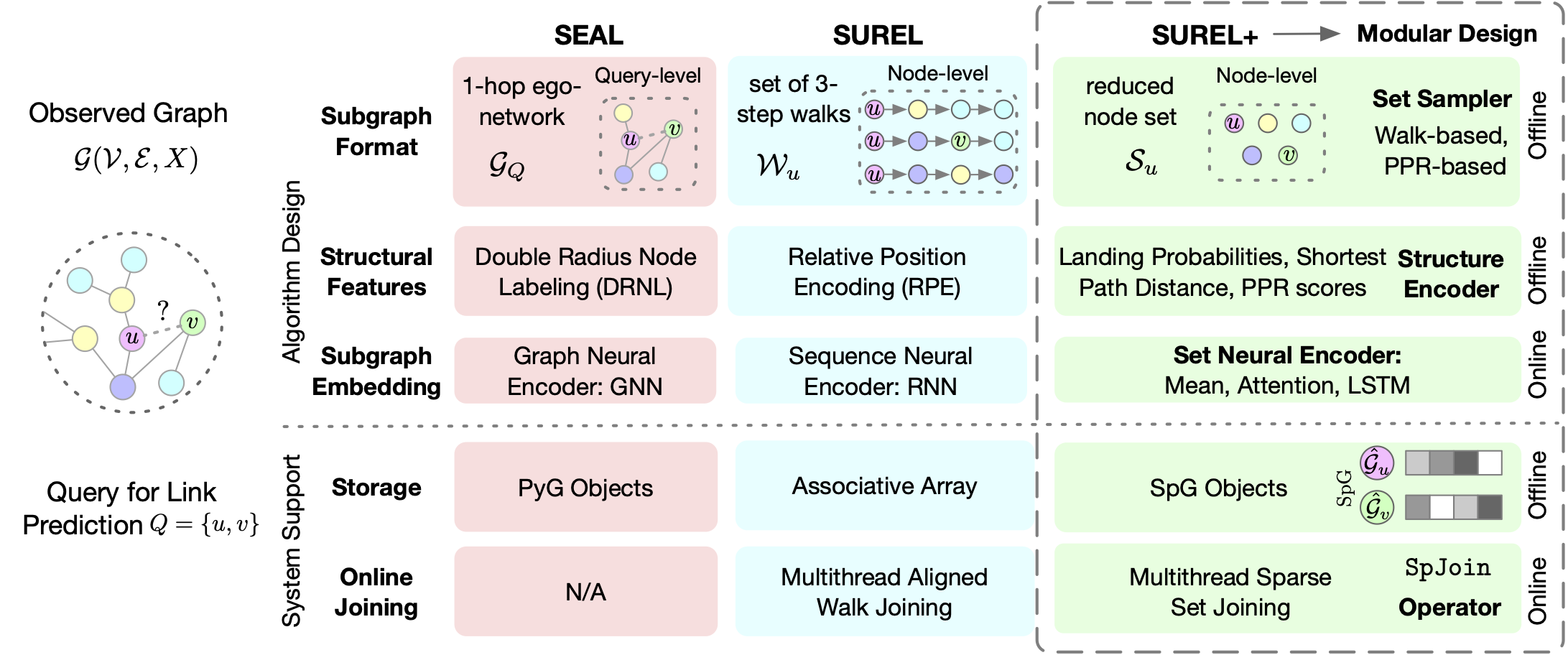SUREL+ is a novel set-based computation framework for scaling subgraph-based GRL to industry-level graphs. It is the first time that SGRL has been successfully deployed on billion-edge graphs. SUREL+ breaks costly subgraph extraction into sampling multiple node sets, where their joint set can act as a proxy of query-induced subgraphs for predictions of multiple queries. For more details, please refer to our paper SUREL+: Moving from Walks to Sets for Scalable Subgraph-based Graph Representation Learning, to appear in VLDB'23.
SUREL+ benefits from the reusability of sampled node sets across different queries (e.g., link, motif), and its set form substantially reduces both memory and computational cost by eliminating heavy node duplication from walk-based sampling. SUREL+ designs dedicated sparse storage SpG and a sparse join operator SpJointo handle the irregular-sized node sets. It adopts a modular design, where users can flexibly choose different set samplers, structure encoders and set neural encoders to suit their own SGRL tasks.
Currently, SUREL+ framework supports the following:
- Large-scale graph ML tasks: link prediction / relation-type prediction / higher-order pattern prediction
- Preprocessing and training on nine datasets in Open Graph Benchmark (OGB) format
- Flexible modules:
- Set Samplers: walk-based, metric-based (PPR)
- Structure Encoders: Landing Probabilities, Shortest Path Distances, PPR scores
- Neural Set Encoders: MLP+mean pooling, LSTM-based, Attention-based
- Single GPU training and evaluation
- Structural Features + Node Features
May 15, 2023:
- support SubGAcc v2.3 for billion-edge graphs
- add two industry-level graph benchmarks
- criteo-click with 16.5M records of online banner ads clicking
- twitter-follower with 1.5B following relations of users
Mar. 1, 2023:
- support SubGAcc v2.2 and ogbl-vessel v1.1
- better logger function
- add model checkpoint and inference-only mode
(Other versions may work but are untested)
- Ubuntu 20.04
- CUDA >= 11.3
- python >= 3.8
- 1.11.0 <= pytorch <= 1.12.0
Requirements: Python >= 3.8, Anaconda3
- Update conda:
conda update -n base -c defaults conda- Install basic dependencies to the virtual environment and activate it:
conda env create -f environment.yml
conda activate sgrl-env- Update: SUREL now supports PyTorch 1.12.1 and PyG 2.2.0 with pyg-lib. To install them, simply run
conda install pytorch==1.12.1 torchvision==0.13.1 torchaudio==0.12.1 cudatoolkit=11.3 -c pytorch
conda install pyg -c pyg
pip install pyg-lib -f https://data.pyg.org/whl/torch-1.12.0+cu113.htmlFor more details, please refer to the PyTorch, PyTorch Geometric and pyg-lib. The code of this repository is lately tested with Python 3.10.9 + PyTorch 1.12.1 (CUDA 11.3) + torch-geometric 2.2.0.
-
Install the required version of PyTorch that is compatible with your CUDA driver
-
Clone the repository
git clone https://github.com/Graph-COM/SUREL_Plus.git -
Build and install the SubGAcc library
cd subg_acc;python3 setup.py install
- To train SUREL+ for link prediction on
collabwith LP/LSTM:
python main.py --dataset ogbl-collab --metric Hits --sencoder LP --num_steps 3 --num_walks 200 --aggr lstm --use_val- To train SUREL+ for link prediction on
ppawith LP/Attn:
python main.py --dataset ogbl-ppa --metric Hits --sencoder LP --num_steps 4 --num_walks 200 --k 20 --aggr attn- To train SUREL+ for link prediction on
citation2with PPR/Mean:
python main.py --dataset ogbl-citation2 --metric MRR --sencoder PPR --topk 100 --aggr mean- To train SUREL+ for
vesselprediction with LP/Mean:
python main.py --dataset ogbl-vessel --metric AUC --sencoder LP --num_steps 2 --num_walks 50 --k 5 --aggr mean --use_raw --dropout 0.2- To train SUREL+ for relation type prediction on
MAG(A-P):
python main.py --dataset mag --relation write --metric MRR --sencoder LP --num_steps 3 --num_walks 100- To train SUREL+ for higher-order pattern prediction on
DBLP:
python main_horder.py --dataset DBLP-coauthor --metric MRR --num_steps 3 --num_walks 100 - All detailed training logs can be found at
<log_dir>/<dataset>/<training-timestamp>.log, and the saved checkpoint is under themodelsubfolder.
usage: main.py [-h] [--device DEVICE] [--log_steps LOG_STEPS] [--num_layers NUM_LAYERS]
[--hidden_channels HIDDEN_CHANNELS] [--dropout DROPOUT]
[--batch_size BATCH_SIZE] [--lr LR] [--train_ratio TRAIN_RATIO]
[--valid_perc VALID_PERC] [--epochs EPOCHS] [--eval_steps EVAL_STEPS]
[--early_stop EARLY_STOP] [--runs RUNS] [--seed SEED] [--alpha ALPHA]
[--eps EPS] [--topk TOPK] [--num_walks NUM_WALKS]
[--num_steps NUM_STEPS] [--k K] [--nthread NTHREAD]
[--dataset {ogbl-ppa,ogbl-ddi,ogbl-citation2,ogbl-collab,ogbl-vessel,mag}]
[--relation {write,cite}] [--metric {AUC,MRR,Hits}]
[--aggrs {mean,lstm,attn}] [--sencoder {LP,PPR,SPD,DEG}] [--use_raw]
[--use_weight] [--use_val] [--use_pretrain] [--load_ppr] [--save_ppr]
[--inf_only] [--log_dir LOG_DIR] [--load_model LOAD_MODEL] [--debug]
Optional Arguments
optional arguments:
-h, --help show this help message and exit
--device DEVICE
--log_steps LOG_STEPS
--num_layers NUM_LAYERS
--hidden_channels HIDDEN_CHANNELS
--dropout DROPOUT
--batch_size BATCH_SIZE
--lr LR
--train_ratio TRAIN_RATIO
--valid_perc VALID_PERC
--epochs EPOCHS
--eval_steps EVAL_STEPS
--early_stop EARLY_STOP
--runs RUNS
--seed SEED seed to initialize all the random modules
--alpha ALPHA teleport probability in PPR
--eps EPS precision of PPR approx
--topk TOPK sample size of node set
--num_walks NUM_WALKS
number of walks
--num_steps NUM_STEPS
step of walks
--k K negative samples
--nthread NTHREAD number of threads
--dataset {ogbl-ppa,ogbl-ddi,ogbl-citation2,ogbl-collab,ogbl-vessel,mag}
dataset name
--relation {write,cite}
relation type
--metric {AUC,MRR,Hits}
metric for evaluating performance
--aggrs {mean,lstm,attn}
type of set neural encoder
--sencoder {LP,PPR,SPD,DEG}
type of structure encoder
--use_raw whether to use raw features
--use_weight whether to use edge weight
--use_val whether to use validation as input
--use_pretrain whether to load pretrained embedding
--load_ppr whether to load precomputed ppr
--save_ppr whether to save calculated ppr
--inf_only whether to perform inference only
--log_dir LOG_DIR log directory
--load_model LOAD_MODEL
saved model path
--debug whether to use debug mode
Please cite our paper if you are interested in our work.
@article{yin2023surel+,
title={SUREL+: Moving from Walks to Sets for Scalable Subgraph-based Graph Representation Learning},
author={Yin, Haoteng and Zhang, Muhan and Wang, Jianguo and Li, Pan},
journal={Proceedings of the VLDB Endowment},
volume={16},
number={11},
pages={2939-2948},
year={2023}
}





